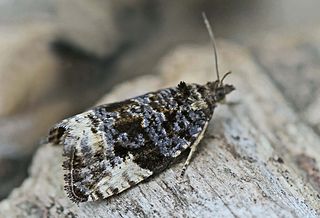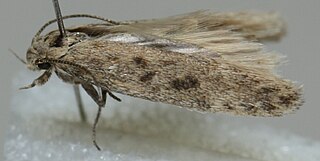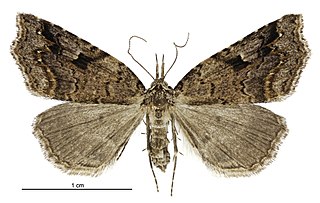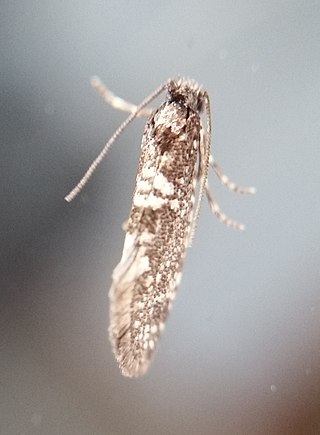
Swammerdamia pyrella is a moth of the family Yponomeutidae. It is found in Europe, North America and Japan.

Falcaria lacertinaria, the scalloped hook-tip, is a moth of the family Drepanidae. The species was first described by Carl Linnaeus in his 1758 10th edition of Systema Naturae It is found in Europe and Anatolia then east to Eastern Siberia.

Agonopterix arenella is a species of moth of the family Depressariidae. It is found in all of Europe, except the Iberian Peninsula.
Philarachnis is a genus of moth in the family Lecithoceridae. It contains the species Philarachnis xerophaga, which is found in India and Sri Lanka.

Paraswammerdamia lutarea is a moth of the family Yponomeutidae. It is found in Europe.

Simyra albovenosa, the reed dagger, is a moth of the family Noctuidae. It is found in most of Europe, then Turkey, Iran, Transcaucasus and into the east Palearctic.

Gypsonoma aceriana, the poplar shoot-borer, is a moth of the family Tortricidae. It is found from Europe to Russia, eastern Turkey and Iraq. It is also present in North Africa.

Agonopterix angelicella is a moth of the family Depressariidae. It is found in most of Europe, except the Iberian Peninsula and south-eastern Europe. It is also found on the Russian plain and Siberia and in Japan.

Hedya pruniana, the plum tortrix, is a species of moth of the family Tortricidae. It is found in the Palearctic realm. In central Europe, it is a common species. In the east, the range extends through Anatolia and Iran, the Ural, Transcaucasia and western Kazakhstan to the Far East.

Phycomorpha metachrysa, the milktree fruit moth, is a species of moth in the Copromorphidae family. It is endemic to New Zealand and has been found in the North and South Islands. The larvae feed on the fruit of species in the genus Streblus including Streblus heterophyllus. This adults of this species is on the wing from October to April.

Sorhagenia rhamniella is a moth in the family Cosmopterigidae. It is found in most of Europe, except the Balkan Peninsula.

Agonopterix ciliella is a moth of the family Depressariidae. It is found in most of Europe, except the Iberian Peninsula, most of the Balkan Peninsula and the Benelux. It is also found in North America.

Swammerdamia caesiella is a moth of the family Yponomeutidae. It is found from most of Europe to Japan. It is also present in North America, where it is possibly an introduced species.

Scrobipalpa obsoletella, the summer groundling, is a moth of the family Gelechiidae. It is found in most of Europe, Turkey, the Caucasus, from Iran to Asian Russia (Transbaikal) and Mongolia. It has also been recorded from New Zealand, South Africa and North America, where it is probably an introduced species. The habitat consists of coastal salt marshes and sandy beaches.

Trigonistis anticlina is a species of moth in the family Noctuidae. It is endemic to New Zealand. Adults of this species inhabit dense native forest habitat in ravines.

Scoriodyta conisalia is a species of moth in the family Psychidae. It was described by Edward Meyrick in 1888. It is endemic to New Zealand and can be found in the North Island. It has been observed at Karikari, Paihia, in the Poor Knights Islands, and in the Auckland and Wellington regions. The species inhabits native forest and coastal areas where it can be found on rocky outcrops and cliffs. Larvae consume algae and lichens. The adults are on the wing from September to March and are active before sunrise.

Trachycentra calamias is a moth of the family Tineidae described by Edward Meyrick in 1886. It is found on the Cook Islands, Fiji, French Polynesia and Tonga.

Microcolona limodes is a species of moth in the family Elachistidae. It is endemic to New Zealand. The larvae of this moth eat the seeds of endemic Myrsine species.
Chionodes kincaidella is a moth in the family Gelechiidae. It is found in North America, where it has been recorded from south-western Alberta to Texas, New Mexico and California.

Tingena chloradelpha is a species of moth in the family Oecophoridae. It is endemic to New Zealand and can be found in the North and South Islands. The larvae live underground forming silken tubes from which it feeds. It overwinters in these tubes and then pupates enclosed in a weak pale white silken cocoon. The adults of this species is variable in appearance both in the depth of colour as well as in its discal spots which may in some specimens be lacking. The adults are on the wing from October until the end of December and can be found inhabiting domestic gardens as well as cultivated land. They have been seen resting on window frames and can be found inside houses.

















